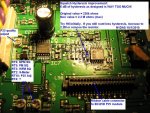RKG said:
You have encountered the phenomenon of hysteresis. Just tighten the squelch a tad more. This is normal.
What I don't like is there tends to be way too much hysteresis designed into the squelch circuit. This often forces me to modify the squelch circuit by either removing or backing off the amount of hysteresis to tailor it to my liking. What I like best is there should be just enough hysteresis to keep the squelch more or less stable at the threshold and no more than that. Any more hysteresis gets in the way of reliably opening on a weak signal that's just barely above the threshold.
Here's a simple test you can try to test the effect of hysteresis:
1. Program in a NOAA weather frequency into an available channel in the scanner. Try to find one that's slightly weak and scratchy in your area but still readable. If there's no NOAA WX broadcast in your area (unlikely but still possible), find an active ham repeater in the 2m and 440 bands. You need a weak but still readable signal that's transmitting continously while you try this experiment.
2. Set the squelch all the way tight or somewhere in between the threshold and all the way tight and just below where it squelches out the weak broadcast you're listening to. Leave the squelch control set at this position. The squelch needs to be open and you need to listen to the weak signal. Instead of playing with the squelch adjustment, we'll be listening to the weak signal while we play with the received signal strength in the next steps.
3. Slowly and carefully decrease the level of signal being received by the scanner. If it's a handheld scanner, you can do this by moving the scanner and finding a "dead spot". The trick is to do this SLOWLY so you notice the signal getting noisier (weaker) and then the squelch eventually closes on the signal. Note the relative amount of noisiness (noise quieting level) of the signal when the squelch finally closes. DO NOT ADJUST THE SQUELCH CONTROL to open the squelch again. Leave the squelch control set where it is.
4. Slowly and carefully INCREASE the level of signal being received by the scanner. With a handheld scanner, slowly and carefully move out of the dead spot found earlier and note the amount of noise quieting heard on the signal when the squelch finally opens again.
5. Try moving in and out of the dead spot in the signal several times, trying different squelch settings. Note the relative amount of noise quieting level heard when the squelch closes on a fading signal and when the squelch finally opens again on the signal as it gets stronger again.
With scanners that have LOTS of hysteresis in the squelch circuit, the signal will have to get MUCH stronger than it was when the signal was fading out to where the squelch closed on the weak signal. I've seen some cases in a couple of scanners where the amount of hysteresis was so great that a signal would become almost all noise before the squelch would finally close and then wouldn't open again until the signal was nearly dead full quieting (DFQ) and very strong.
Where I've seen too much hysteresis be a problem is when there's a weak but still readable signal on a channel and the squelch would stay open on it if it were already open to begin with but it never opens because there's never enough signal to open it in the first place. This drives me nuts and eventually forces me to optimize the hysteresis in the circuit. The excessive amount of hysteresis gets in the way of reliable squelch operation.
I recall many old Regency scanners back in the 70's and 80's were designed with absolutely NO hysteresis whatsoever. What was good about these circuits was that if a signal was strong enough to be above the threshold, you heard it. If it was below the threshold, you didn't. The squelch would reliably hold open on a weak signal provided it stayed above the threshold level. The bad part was when a signal was weak and hovering around the threshold, causing the squech to constantly chatter or sputter or just crackle as the signal was just strong enough to partially crack it open. These squelch circuits could have been helped a lot by just a little bit of hysteresis...add in just enough to get rid of instability at the threshold but not enough to get in the way.
If you've got a scanner with NO hysteresis at all in the squelch, it will have no "dead zone" like a circuit with lots of hysteresis will. You'll notice the tendency to chatter or sputter open and closed as the weak signal hovers around the threshold.
I've found a lot of well designed 2-way radios have just enough hysteresis in their squelch circuits to get rid of the tendency to chatter at the threshold and NO MORE THAN THAT. The exact amount of hysteresis has been optimized for the particluar design. I've found from experience over the years that this is the amount of hysteresis I like best.


